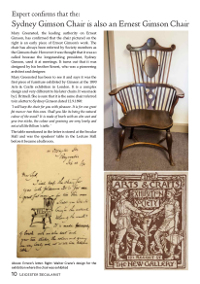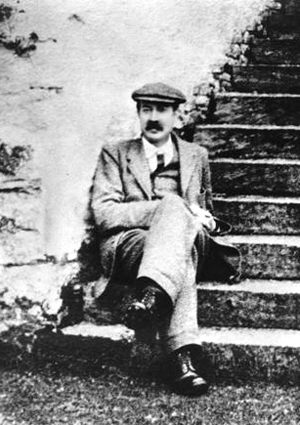Josiah Gimson (1818-1883)
In 1842 Josiah Gimson and his brother, Benjamin, set up Gimson and Company, a successful engineering company in Leicester making heavy machinery (see Leicester Foundries 1845-1914 by G.T. Rimmington page 66). A large new foundry, the Vulcan Works, was built near Humberstone Road between 1876 and 1879 with its own rail-siding. Between 1889 and 1891 the firm of Gimson and Company cast the great beam engines which pumped sewage as part of a new system of municipal sanitation to combat the recurrent outbreaks of diarrhoea. These can still be seen (sometimes working) at the Abbey Pumping Station, now a museum. At about the same time the firm also cast two large bridges, over the Grand Union Canal at Upperton Road and Mill Lane. He lived at 4 Belmont Villas.
Josiah Gimson became quickly established as an important and influential manufacturer in Leicester. His engineering firm was one of the largest employers in the city and prided itself on being a model employer in terms of wages and conditions of work. In 1877 he was elected as a Liberal councilor in the ward of West St Mary’s. Josiah was one of the most important pioneers of secularism and particularly of the Leicester Secular Society, and provided most of the money for the building of the Secular Hall and in his will left a further £1000 to for the project.
He is buried in Welford Road cemetery. The business was left to the mechanical engineers of the family: sons Josiah Mentor, Sydney Ansell and Arthur together with his nephew, another Josiah, as Ernest Gimson was already becoming established as an innovative architect and designer
Ned Newitt on Josiah Gimsom in LSS Newsletter, April 2008.
J. Mentor Gimson
Eldest son of Josiah Gimson, Josiah became the Manager of the Secular Hall until its transfer to the Leicester Rationalist Trust (i.e. the Secular Society).He was President of the Leicester Literary and Philosophical Society 1900-91.
Sydney Ansell Gimson (1860-1938)
President of Leicester Secular Society from 1889 until shortly before his death. Further details of his life are available in "The Who's Who of Radical Leicester". He wrote Random Recollections of the Leicester Secular Society 1932, which is now in the Wigston Records Office. There is an extract below in the section on Ernest Gimson, and others on our William Morris page.
Ernest William Gimson (1864-1919)
Ernest Gimson was influenced by the Arts and Crafts movement of William Morris and is still highly regarded as a furniture designer.
A chair that was the first piece of furniture exhibited by Ernest at the 1890 Arts & Crafts exhibition in London and subsequently given to his brother Sydney is resident in the Hall. An article that Ned Newitt has written about the chair can be found here.
The Leicester Arts and Museums Service now has a website devoted to him and his work: Ernest Gimson and the Arts and Crafts Movement in Leicester.
See also: Ernest Gimson as a Designer.
The following passage from Sydney Gimson's Recollections follows on from his account of the lecture on Art and Socialism given in 1884 by William Morris:
In those days of my single life I had a small smoke room adjoining my bedroom, for my mother could not bear smoking in the usual living rooms of our home. There I kept my growing collection of books and there I took visitors for a final chat and smoke before retiring for the night. When Mr. Hopps had left, Morris, my sister Sarah, Ernest, and I, went up there and had a delightful talk which I can never forget. Sarah left after about an hour but the other three of us sat talking until nearly 2 o-clock.
I am sure that one reason for this long sitting was that Morris was particularly interested in Ernest, then 19 years old and articled to the Leicester Architect Isaac Barradale, and saw something of the possibilities in him. At any rate when Ernest was anxious to have some experience in a London Architect's office, some two years later, he, after much hesitation for fear of intrusion, wrote to ask Morris's advice and perheps a letter of introduction to a suitable Architect. At once Morris sent him three letters of introduction. Delighted and excited, Ernest took the three letters up to London, but he only had to present one, to J. D. Sedding, who at once took him into his office where Ernest stayed for two years.
While in London he joined several Societies and Committees with which Morris was actively associated, came continuously under his influence, learnt a great deal from him and was imbued with those ideals which governed the rest of his life. Between his first visit to us in 1884 and Ernest's going to London in 1886, Morris had paid us several visits and had, no doubt, become sure that Ernest would grow to something worth while under the right influence. Ernest went far and was recognised as one of the great craftsmen of his generation. I know that he always felt that he owed his great opportunity to the visits of William Morris to Leicester.
It was very appropriate that Ernest was invited by Morris's daughter to design Kelmscott Village Hall as a Memorial to him. He completed the commission shortly before he died and the Hall was opened to the public in October 1934 by George Bernard Shaw, to coincide with the centenary of William Morris’ birth.
Sydney also mentions Ernest in part 2 of his recollections:
While he was in Leicester Ernest was active in helping down at the Hall. In all the Social gatherings he was a tower of strength for he had a real gift for entertaining any company with a bit of acting or singing and keeping the folk alive and jolly with all sorts of games. With it all he was essentially shy but woke up as any company responded to his magnetic personality. Together we used to prepare the platform for entertainments, concerts, acting, etc. He rigged up a curtain to go right across the Hall and I believe it served for over 30 years. He went to London in 1886 and, though he came down occasionally, I missed his help sadly. Later, when he lived in Gloucestershire, he was lost to our Leicester movement altogether but he never weakened in his Freethought opinions.
One of my happiest recollections of the time when he was in Leicester is of a walk we had one Sunday with Tom Barclay (still one of our most popular members) and Mr. Robson. We were almost all the time discussing the interminable question of Socialism and Individualism, Barclay & Robson, v Ernest and me. I don’t think we saw much of the country, we were too keen on our arguments, though it was a lovely day. We took a picnic lunch with us, which we ate on a grassy slope in Bradgate Park. There were occasional digressions to pick a flower or a leaf and admire it, for Robson was an enthusiastic botanist. I think we dozed part of the afternoon and then had a “Forest” tea in a Newtown Linford Cottage, walking back to Leicester and continuing our discussion in the cool of the evening. It was a hot day, a warm but always friendly discussion, and a treasured remembrance.
Other Family Members
There was another brother, Arthur James Gimson who was Hon. secretary and treasurer of the Leicestershire Footpath Association for nearly thirty years, and two sisters Sarah and Carry. See the Recollections of G. W. Foote and G. J. Holyoake for other brief references to them and to Mentor.
Other Resources
- The Gimson Family and the Leicester Secular Society from Leicester City Council's Arts and Crafts Movement website.
- Wikipedia Entry
Page updated 3/12/2024
















